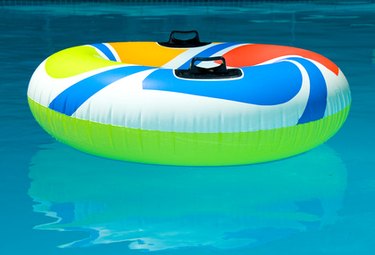Salt water pools are gaining in popularity largely due to their benefits over traditional swimming pools. Salt water pools can generate hypochlorous acid, or chlorine, and reduce the need for pool chemicals. The lack of chemicals means less money spent and less time testing and maintaining the proper chemical levels in the water. Salt water pools are typically less harsh on the skin, reducing the dry skin and irritated eyes often associated with typical chlorinated pools. Determining salt levels and adding salt to your pool before opening for the first swim of the season is fairly simple. A saline test will tell you how much salt or chlorine is already in the pool and how much more must be added or subtracted.

Video of the Day
Things You'll Need
Salt (Solar Salt Flakes, Food Grade Salt, Brine Blocks, Water Softener Pellets)
Saline Test
Step 1
Purchase a saline test from the pool supply store. Follow the instructions to test to salt content of your pool. This will determine the level of salt already in the pool, whether from chlorine tablets or salt water. To know how much salt you must add to the water before opening the pool, this test is imperative. You only need to conduct a saline test once or twice a year.
Video of the Day
Step 2
Determine the amount of salt you must add to your pool to obtain the optimal level. Ideally, you want between 2,000 and 4,000 parts per million. To obtain 4,000 parts per million in a freshly filled pool with no salt water, add 50 pounds of salt per 2,000 gallons. Calculate how much salt you will need to add based on the number of gallons in your pool.
Step 3
Open the pool’s drain and turn on the pump. Slowly pour the salt into the pool’s pump.
Step 4
Run the pump for at least 24 hours to dissolve and disperse the salt throughout the pool.
Step 5
Use a chlorine generator to eliminate bacteria and algae build up. A chlorine generator produces chlorine from the salt water through the process of electrolysis. The water passes through the generator, salt is converted to common chlorine then ultimately reverts back to salt. You don't need chlorine tables. The salt does not run out, resulting in little maintenance and lower costs without having to purchase the tablets of chlorine.
Warning
Too much salt can lead to salty-tasting water and eventually corrode pool equipment. If your pool contains excess salt content (more than 6,000 part per million), you need to drain some of the water, refill with fresh water and retest the salt levels.